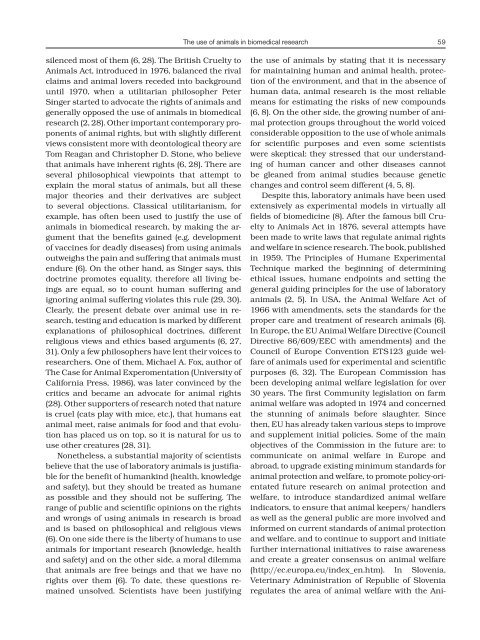SLOVENIAN VETERINARY RESEARCH
SLOVENIAN VETERINARY RESEARCH
SLOVENIAN VETERINARY RESEARCH
Create successful ePaper yourself
Turn your PDF publications into a flip-book with our unique Google optimized e-Paper software.
The use of animals in biomedical research59silenced most of them (6, 28). The British Cruelty toAnimals Act, introduced in 1976, balanced the rivalclaims and animal lovers receded into backgrounduntil 1970, when a utilitarian philosopher PeterSinger started to advocate the rights of animals andgenerally opposed the use of animals in biomedicalresearch (2, 28). Other important contemporary proponentsof animal rights, but with slightly differentviews consistent more with deontological theory areTom Reagan and Christopher D. Stone, who believethat animals have inherent rights (6, 28). There areseveral philosophical viewpoints that attempt toexplain the moral status of animals, but all thesemajor theories and their derivatives are subjectto several objections. Classical utilitarianism, forexample, has often been used to justify the use ofanimals in biomedical research, by making the argumentthat the benefits gained (e.g. developmentof vaccines for deadly diseases) from using animalsoutweighs the pain and suffering that animals mustendure (6). On the other hand, as Singer says, thisdoctrine promotes equality, therefore all living beingsare equal, so to count human suffering andignoring animal suffering violates this rule (29, 30).Clearly, the present debate over animal use in research,testing and education is marked by differentexplanations of philosophical doctrines, differentreligious views and ethics based arguments (6, 27,31). Only a few philosophers have lent their voices toresearchers. One of them, Michael A. Fox, author ofThe Case for Animal Experomentation (University ofCalifornia Press, 1986), was later convinced by thecritics and became an advocate for animal rights(28). Other supporters of research noted that natureis cruel (cats play with mice, etc.), that humans eatanimal meet, raise animals for food and that evolutionhas placed us on top, so it is natural for us touse other creatures (28, 31).Nonetheless, a substantial majority of scientistsbelieve that the use of laboratory animals is justifiablefor the benefit of humankind (health, knowledgeand safety), but they should be treated as humaneas possible and they should not be suffering. Therange of public and scientific opinions on the rightsand wrongs of using animals in research is broadand is based on philosophical and religious views(6). On one side there is the liberty of humans to useanimals for important research (knowledge, healthand safety) and on the other side, a moral dilemmathat animals are free beings and that we have norights over them (6). To date, these questions remainedunsolved. Scientists have been justifyingthe use of animals by stating that it is necessaryfor maintaining human and animal health, protectionof the environment, and that in the absence ofhuman data, animal research is the most reliablemeans for estimating the risks of new compounds(6, 8). On the other side, the growing number of animalprotection groups throughout the world voicedconsiderable opposition to the use of whole animalsfor scientific purposes and even some scientistswere skeptical: they stressed that our understandingof human cancer and other diseases cannotbe gleaned from animal studies because geneticchanges and control seem different (4, 5, 8).Despite this, laboratory animals have been usedextensively as experimental models in virtually allfields of biomedicine (8). After the famous bill Crueltyto Animals Act in 1876, several attempts havebeen made to write laws that regulate animal rightsand welfare in science research. The book, publishedin 1959, The Principles of Humane ExperimentalTechnique marked the beginning of determiningethical issues, humane endpoints and setting thegeneral guiding principles for the use of laboratoryanimals (2, 5). In USA, the Animal Welfare Act of1966 with amendments, sets the standards for theproper care and treatment of research animals (6).In Europe, the EU Animal Welfare Directive (CouncilDirective 86/609/EEC with amendments) and theCouncil of Europe Convention ETS123 guide welfareof animals used for experimental and scientificpurposes (6, 32). The European Commission hasbeen developing animal welfare legislation for over30 years. The first Community legislation on farmanimal welfare was adopted in 1974 and concernedthe stunning of animals before slaughter. Sincethen, EU has already taken various steps to improveand supplement initial policies. Some of the mainobjectives of the Commission in the future are: tocommunicate on animal welfare in Europe andabroad, to upgrade existing minimum standards foranimal protection and welfare, to promote policy-orientatedfuture research on animal protection andwelfare, to introduce standardized animal welfareindicators, to ensure that animal keepers/ handlersas well as the general public are more involved andinformed on current standards of animal protectionand welfare, and to continue to support and initiatefurther international initiatives to raise awarenessand create a greater consensus on animal welfare(http://ec.europa.eu/index_en.htm). In Slovenia,Veterinary Administration of Republic of Sloveniaregulates the area of animal welfare with the Ani-
















